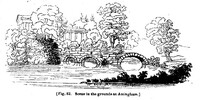In opposition to Mr. Price's idea, that all improvement of scenery should be derived from the works of great painters, I shall observe, that there are, at present, very near the house, some fragments of an old mill, and brick arches [see fig. 82], that make a charming study for a painter; the composition is not unlike a beautiful picture of Ruisdale's, at ATTINGHAM, which every man of taste must admire: of this scene, as it now exists, I have endeavoured to give a faint idea. Among the trees is seen part of the colonnade that joins the east wing to the body of the house: from the general character of this scenery, we cannot but suppose this to be a fragment of some ruined Grecian temple, and no part of a modern inhabited palace. Hence it is evident, that the mind cannot associate the ideas of elegance with neglect, or perfect repair and neatness with ruin and decay: such objects, therefore, however picturesque in themselves, are incongruous and misplaced, if near such a palace as ATTINGHAM. Another mistake of the admirers of painters' landscape is, the difference in the quantity of a natural and an artificial composition: the finest pictures of Claude (and here again I may refer to a picture at ATTINGHAM) seldom consist of more than one-fifth of that field of vision which the eye can with ease behold, without any motion of the head, viz. about 20 degrees out of 90; and we may farther add, that, without moving the body, our field of vision is extended to 180 degrees.

